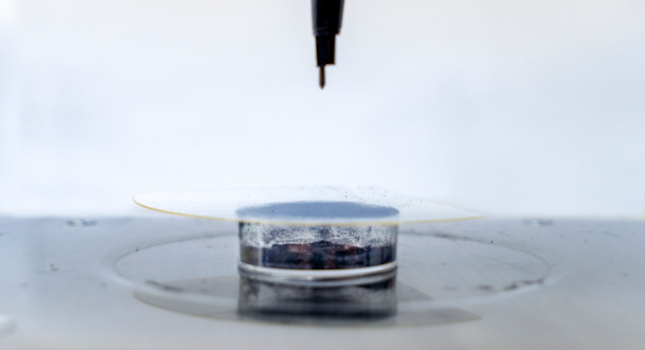Engineers develop method that eliminates need for polymer binders
Using electrostatic force in Corona-Enabled Electrostatic Printing instead of polymer binders allows many e-skin sensors to be printed quicker
A team of engineers at the University of South Florida has invented new technology that could forever change the manufacturing of wearable, electronic sensors. They’ve figured out a way to speed up production without having to use polymer binders – the industry standard in printing flexible sensors, which are often used to monitor vital signs in health care settings.
Their technology, featured on the cover of the journal ACS Applied Materials and Interfaces, prints electronic skin, or “e-skin,” by using corona discharge to create a strong electric field between binder-free functional powders, such as graphene and flexible, non-conductive surfaces, such as medical tape. The electrostatic force used in Corona-Enabled Electrostatic Printing enables a multitude of e-skin sensors to be printed within sub-seconds, compared to the 20 minutes it takes with polymer binders and doesn’t require heat. E-skin is micrometer-thin, pliable technology that can be used to measure things such as strain, temperature and sound.

Courtesy: University of South Florida
Ying Zhong, assistant professor of mechanical engineering at USF, and her collaborator, Long Wang at California Polytechnic State University, found that the printing technique has broad applications, such as in health monitoring, prosthetics and robotics. Unlike with polymer binders, there aren’t sizing limitations, making the technique a strong candidate for the roll-to-roll manufacturing of large flexible sensors, which can greatly reduce production costs.
“As a new, advanced manufacturing strategy, Corona-Enabled Electrostatic Printing will potentially transform the cost structure for large-area and high-performance electronics and enable versatile applications of flexible, functional systems,” Zhong said. “The technique can help contribute to maintaining the U.S.’s leadership in advanced manufacturing.”
Zhong recently received a $308,928 grant from the National Science Foundation to advance her research, proving the patent-pending ultra-fast manufacturing technique can be used to print materials beyond multifunctional e-skin.
Do you have experience and expertise with the topics mentioned in this content? You should consider contributing to our CFE Media editorial team and getting the recognition you and your company deserve. Click here to start this process.


